West Edge's Marley/Manga Flute
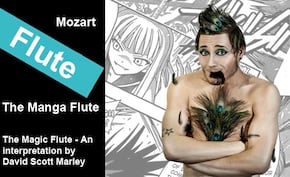 No matter how many productions you might have seen of Mozart’s Magic Flute, almost certainly none was like what West Edge Opera is serving up March 4–11. It’s the famously “different” David Scott Marley’s new English adaptation in Japanese manga (comics/cartoons) style.
No matter how many productions you might have seen of Mozart’s Magic Flute, almost certainly none was like what West Edge Opera is serving up March 4–11. It’s the famously “different” David Scott Marley’s new English adaptation in Japanese manga (comics/cartoons) style.
In Marley’s resume: Bat Out of Hell (adaptation of Johann Strauss’ Die Fledermaus), The Riot Grrrl on Mars (née Rossini’s L’Italiana in Algeri), Daughter of the Cabinet (née Lecocq’s La Fille du Madame Angot), and so on.
So why “Manga Flute”? The answer is reminiscent of Sammy Cahn’s to the question of which comes first, words or music — “the phone call.” In Marley’s case, it was West Edge Artistic Director Mark Streshinsky who commissioned the English version. The suggestion was not love at first sight:
I was doubtful at first, because while I love the music of Magic Flute, there are a lot of things about the story I dislike. Not just the horrible things that are said about blacks and women — those are awful but they also wouldn’t be hard to eliminate.What was more difficult to find a way around is that I don’t agree with the whole philosophy of the opera, and that’s woven into the story and the structure of the music in a way that’s very hard to find a way to separate. I don’t believe we achieve enlightenment by defeating the unenlightened, nor by using force to humiliate our enemies, as Papageno does to Monostatos at the end of Act I.
But Mark said the magic words to me: ‘I encourage you to be as wild and crazy as you want to get.’ I asked him if I could keep the characters and the music and change the story, and he thought about it and said, ‘Sure.’ That was music to my ears because my last several adaptations have been more serious and I really wanted to write another comedy now.
So I started thinking about how I could, first of all, make this fun and lively, and second, say something through the story that I feel good about saying.
The first part of that led to the idea of doing this in the style of manga and anime, Japanese-style graphic novels and animated movies. Those are sort of a modern equivalent of the popular ‘magic plays’ of Mozart’s time. Their stories blend magic and fantasy with all sorts of serious concerns — politics, difficult family problems, what we’re doing to our environment, the causes and consequences of war.
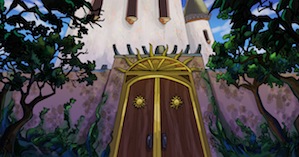 Marley says he is a big fan of Hayao Miyazaki’s movies, as am I, and after watching several of them again, he applied elements of Miyazaki’s inventive use of Japanese folklore. And so, look for the three boys appearing as raccoons, who go back and forth between giving the main characters wise advice and playing terrible pranks on them.
Marley says he is a big fan of Hayao Miyazaki’s movies, as am I, and after watching several of them again, he applied elements of Miyazaki’s inventive use of Japanese folklore. And so, look for the three boys appearing as raccoons, who go back and forth between giving the main characters wise advice and playing terrible pranks on them.
Marley’s Sarastro isn’t as noble and wise as often advertised, and the Queen of the Night — Queen Starfire here — isn’t completely bad, with some legitimate grievances against Sarastro.
When Tamino rescues Pamina, she isn’t sure right away whether she really loves him, or even likes him all that much. In the second act in particular, I’ve changed things considerably, and the happy ending is not achieved because one side defeats the other.
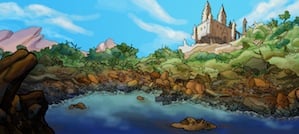 Performances in the El Cerrito Performing Arts Theater are conducted by Jonathan Khuner and directed by Caroline Altman; manga art is by Megan Willis and video animation by Jeremy Knight.
Performances in the El Cerrito Performing Arts Theater are conducted by Jonathan Khuner and directed by Caroline Altman; manga art is by Megan Willis and video animation by Jeremy Knight.
Leading the cast: Heidi Moss (Pamina), Elyse Nakajima (Queen), Lori Schulman (Papagena), Darron Flagg (Tamino), Eugene Brancoveanu (Papageno), Keith Perry (Monostatos), and Cliff Romig (Sarastro).
Says Streshinsky of this production and his “Popera” season:
I think more and more about the audience. Opera folk are always trying to come up with gimmicks to get new audiences into the theater, but I think it is equally important to think about the step after that.Namely, how to make opera performances speak to a modern audience that is already enticed to the theater. I believe that if we consider opera to be not just great art, but great entertainment as well, then we will demystify the art form.
Luisotti Named Music Director of Teatro di San Carlo
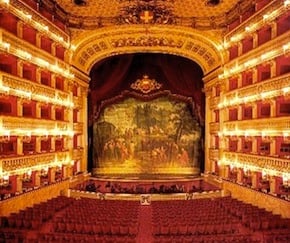 San Francisco Opera Music Director Nicola Luisotti has been appointed music director of Teatro di San Carlo of Naples, Italy, effective immediately. He succeeds former Principal Conductor Maurizio Benini and Music Director Jeffrey Tate. Born and raised in Tuscany, the 50-year-old Luisotti is also principal guest conductor of the Tokyo Philharmonic.
San Francisco Opera Music Director Nicola Luisotti has been appointed music director of Teatro di San Carlo of Naples, Italy, effective immediately. He succeeds former Principal Conductor Maurizio Benini and Music Director Jeffrey Tate. Born and raised in Tuscany, the 50-year-old Luisotti is also principal guest conductor of the Tokyo Philharmonic.
Founded in 1737, San Carlo is the oldest continuously active theater in Europe, and one of Italy’s most prestigious opera houses, famous for its beauty and acoustics. At the time of its opening — with Domenico Sarro’s Achille in Sciro — it was the largest opera house in the world, seating 3,300.
Among composers who staged their works at the theater were Rossini, Donizetti, Verdi, Mascagni, Leoncavallo, Giordano, and Cilea. In 2010, the theater was reopened after a major reconstruction, which restored its five-level horseshoe of boxes upholstered in red and decorated in gold leaf, its frescoed ceiling, and its famous stage curtain.
The official announcement is scheduled for a press conference on March 7, when Luisotti begins rehearsals there for Gabriele Lavia’s production of Verdi’s I masnadieri. There is no word yet from the San Francisco Opera, but the Naples appointment will probably not affect Luisotti’s schedule here.
S.F. Opera General Director David Gockley said he was “thrilled by the appointment ... which is a tribute to Nicola’s musical talent and leadership.” Luisotti’s San Francisco appointment began in 2009 and continues through the 2015–2016 season.
Chicago Novelties: Alternative Energy, Night Ferry
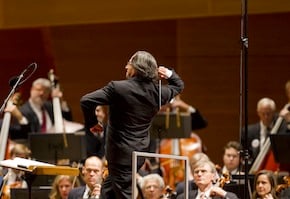 The two commissioned works on the programs of the Chicago Symphony in Davies Symphony Hall next week are intriguing and promising.
The two commissioned works on the programs of the Chicago Symphony in Davies Symphony Hall next week are intriguing and promising.
Mason Bates’ Alternative Energy had its world premiere in Chicago on Feb. 2, and will be performed in San Francisco, under Riccardo Muti’s baton, on Feb. 14.
Anna Clyne’s Night Ferry will be heard for the first time in Chicago’s Symphony Center on Feb. 9, and in Davies Hall on Feb. 15.
Both Bates and Clyne are Chicago Symphony Mead composers in residence; they are called by Muti “artists who write from the heart, who defy categorization, and who reach across all barriers and boundaries.” Bates is also a 2011–2012 Project San Francisco composer.
Bates worked on what he calls his “Energy Symphony” for a year, composing, editing, proofing, and mixing at Skywalker Studios. He describes the work as
… spanning four movements and hundreds of years. Beginning in a rustic Midwestern junkyard in the late 19th century, the piece travels through ever greater and more powerful forces of energy — a present-day particle collider, a futuristic Chinese nuclear plant — until it reaches a future Icelandic rainforest, where humanity’s last inhabitants seek a return to a simpler way of life.These worlds are conjured by a variety of symphonic effects. A blues fiddle accompanied by car parts dominates the ‘old-time’ first movement (the principal percussion, Cynthia Yeh, plays a ‘car part drumset’ assembled from scraps collected at a junkyard).
Actual recordings of Chicago’s FermiLab particle accelerator appear in highly dramatic form in the present-day movement (think: massive machines waking up all around you). Surreal and trippy microtonal sonorities take us to the edge of a future industrial wasteland in China’s Xinjiang province.
And gently out-of-town, gamelan-sounding figuration, complemented by surround-sound jungle recordings and future birdsong, brings us to the far-off rainforest where the piece ends.
Like the tone poems of Berlioz or Liszt — though very different in sound — this piece uses an idée fixe, or melody, to link everything together. This tune is heard on the fiddle, which conjures a figure like Henry Ford working in his junkyard, and is accompanied by an Œphantom orchestra’ that trails the fiddler like ghosts.
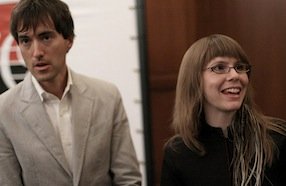
Clyne’s composition has an exotic orchestration, including Tibetan singing bowls. It takes its name from a passage in Seamus Heaney’s Elegy for Robert Lowell, the poet who, Clyne notes, suffered from manic depression, similar to Schubert, whose music dominates the program. Clyne writes:
Night Ferry is music of voyages, from stormy darkness to enchanted worlds. It is music of the conjurer and setter of tides, the guide through the ‘ungovernable and dangerous.’ Exploring a winding path between explosive turbulent chaoticism and chamber lyricism, this piece weaves many threads of ideas and imagery.These stem from Riccardo Muti’s suggestion that I look to Schubert for inspiration, as Night Ferry will be premiered with Entr’acte No. 3 from Rosamunde and his Symphony in C Major.
Voci Anniversary Season Reaches Into the Far North
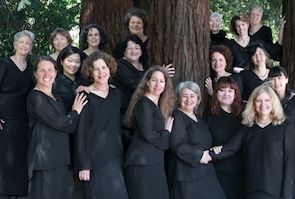 Voci Women’s Vocal Ensemble, headquartered in the East Bay, will cap its 20th anniversary season with a tour to the Tapestry International Festival of Women’s Choirs in Vancouver. The group’s program there will consist of selections from Voci’s gala performances March 24 and 25 in Oakland and Berkeley.
Voci Women’s Vocal Ensemble, headquartered in the East Bay, will cap its 20th anniversary season with a tour to the Tapestry International Festival of Women’s Choirs in Vancouver. The group’s program there will consist of selections from Voci’s gala performances March 24 and 25 in Oakland and Berkeley.
The 24-woman ensemble was selected as one of three women’s choruses in North America to perform at the festival, hosted by the Elektra Women’s Choir.
Jude Navari, Voci’s artistic director for the past 12 years, says the invitation is “thrilling.” The conductor, who is also active in the Bay Area as a composer and pianist, is looking forward to the festival’s four days, culminating on May 5 in a multichoir finale, featuring the premiere of a newly commissioned work for women’s choir and brass ensemble by Vancouver Symphony Conductor Bramwell Tovey.
The East Bay gala concerts, called “The River Has Many Voices: Voci’s 20th Anniversary Retrospective,” features contemporary works from Voci’s repertoire, plus the premiere of a new choral cycle by Navari. Half of the works were written especially for Voci. Featured composers include Ann Callaway, Steven Clark, Gabriella Frank, Peter Knell, Libby Larsen, David Meckler, and Stephen Paulus.
Navari’s new work, Siddhartha Fragments, weaves together passages from Herman Hesse’s novel. Navari, 42, says, Siddhartha was an important book for him as a teenager.
“I was especially drawn to the passages about the river from which I culled the ‘fragments’ for this choral piece. After almost thirty years, I still found them potent and beautiful. This inspired me to set them as a birthday gift to Voci.” The work will also feature Voci’s pianist, Sharon Lee Kim.
Music to Cry By
“Listening to a sad song has reduced seven out of ten men to tears, according to the study. And almost 90 per cent of women admit listening to an emotional song or passage of music has made them cry,” says an article in The Telegraph.The subject is pop & rock, with REM’s Everybody Hurts in the lead, beating Elton John’s Candle in the Wind.
But let’s talk turkey here, and find out who and what are the weepy-makers in classical music. Tchaikovsky and Mahler, of course, but there’s a wide range of choices. What works move you to tears just about every time you hear them?
Comments welcome below, as always.
Happy Birthday, GG Bridge!
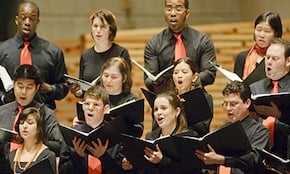 International Orange Chorale San Francisco has announced winners of the Golden Gate Bridge 75th Anniversary Composer Competition. Dominick DiOrio’s Chrysopylae will be premiered by IOCSF, along with David Conte’s new commission, Facing West.
International Orange Chorale San Francisco has announced winners of the Golden Gate Bridge 75th Anniversary Composer Competition. Dominick DiOrio’s Chrysopylae will be premiered by IOCSF, along with David Conte’s new commission, Facing West.
Performances will take place on May 27 at Crissy Field as part of the anniversary celebrations, hosted by the Golden Gate Bridge National Parks Conservancy. Second prize went to Julian Mörth for Hymn of Victory.
The composer competition encouraged choral composers to express the beauty of the Golden Gate Bridge through choral music.
DiOrio, director of choral activities and associate professor of music at Lone Star College–Montgomery, said, “I am so delighted to be the winner of IOCSF’s competition. I first heard the International Orange Chorale of San Francisco during the Chorus America National Conference last June and was blown away by their fine ensemble singing and dedication to contemporary repertoire. I wrote Chrysopylae with their distinct sound in mind, and I can’t wait to hear them bring my music to life as part of the Golden Gate Bridge celebrations in San Francisco.”
MasterGuild Concerts
The next series of MasterGuild concerts in the Regents’ Theater on the campus of Holy Names University begins on Feb. 12. Pianist Roy Bogas writes:This concert is rather special, as it marks a rare appearance of Carey Bell, S.F. Symphony principal clarinetist in a chamber music program with the best artists the Bay Area has to offer — Axel Strauss, the fabulous violinist who is also on the faculty at the S.F. Conservatory, plus three members of the S.F. Symphony: Peter Wyrick, the associate principal cellist; Amy Hiraga, sensitive violinist par excellence, who doesn’t mind playing second violin to Axel; and Nancy Ellis, longtime violist whose chamber music experience reaches as far back as the Griller Quartet and the heyday of Mills College.The program opens with Brahms’ F-Minor Clarinet Sonata (with Bell and Bogas), continues with Mozart’s Piano Quartet in E-Flat Major, and closes with the Brahms Clarinet Quintet.
Concerts take place in Oakland in the Regents' Theater, Valley Center for the Performing Arts, at Holy Names University in Oakland, 3500 Mountain Blvd. on Sundays at 7:15 P.M. Admission prices are $20 general, $15. seniors and $5.
'Sounds of India' in the Asian Art Museum
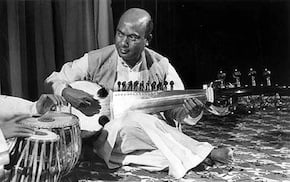 Two events honoring the legacy of the legendary Indian musician and teacher Ali Akbar Khan are scheduled in the Asian Art Museum’s Samsung Hall, Feb. 19 and 26.
Two events honoring the legacy of the legendary Indian musician and teacher Ali Akbar Khan are scheduled in the Asian Art Museum’s Samsung Hall, Feb. 19 and 26.
The first event, sponsored by the Society for Asian Art, is the screening of Play Like a Lion, the newly released and highly acclaimed film about Ali Akbar’s fascinating life.
After the screening, there will be a discussion with filmmaker Joshua Mellars and Ali Akbar’s son Alam Khan.
An Exception to Squeezing Round Opera Into Square Film
 It’s almost always awkward and phony: characters in a film go to the opera, usually reluctantly, fish-out-of-water, regularly giving in to it — Pretty Woman, Moonstruck, you finish the list.
It’s almost always awkward and phony: characters in a film go to the opera, usually reluctantly, fish-out-of-water, regularly giving in to it — Pretty Woman, Moonstruck, you finish the list.
I don’t mean use of music, such as Cosi fan tutte in Sunday Bloody Sunday, and among operatic settings in film, I love the “Il dolce suono” scene in The Fifth Element.
But for making the operagoing experience a believable part of the story, the use of “Casta diva” and especially the climactic “Hoffmann Barcarole” at the Metropolitan Opera in Margaret is exceptional. I also recommend the film — coming to the S.F. Film Society Cinema, Feb. 17–23 — for a good number of other reasons. (The Barcarole also served Life Is Beautiful well.)
Dudamel's 'Mahler Capital of North America'
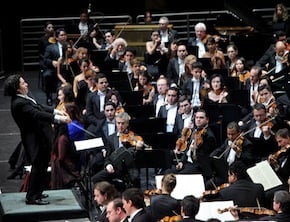 “The Mahlerian center of gravity in North America shifted from Manhattan to snap into place beneath Los Angeles, minutes after Gustavo Dudamel and over 1000 musicians onstage at Shrine Auditorium finished Gustav Mahler’s Eighth Symphony,” says a report from the conclusion of the L.A. Philharmonic’s Mahler Project.
“The Mahlerian center of gravity in North America shifted from Manhattan to snap into place beneath Los Angeles, minutes after Gustavo Dudamel and over 1000 musicians onstage at Shrine Auditorium finished Gustav Mahler’s Eighth Symphony,” says a report from the conclusion of the L.A. Philharmonic’s Mahler Project.
So, it’s the N.Y. Giants in the Super Bowl and Dudamel/L.A. at the Mahlerian heights:
There are noteworthy Mahler conductors in Europe — Simon Rattle, Claudio Abbado, Valeri Gergiev, Lorin Maazel, Pierre Boulez — but there’s an odd void in the U.S. The New York Philharmonic can still claim that Mahler once conducted their orchestra and Leonard Bernstein popularized Mahler’s music there in the ’60s, but Alan Gilbert has had a bumpy ride there. James Levine — a Mahler maestro — stepped down in Boston, and no one knows when he’ll conduct again.That leaves Michael Tilson Thomas and the San Francisco Symphony as The Dude’s only real Mahlerian competition in North America, but has MTT conducted all nine in three weeks? San Francisco: you’ve been served!
